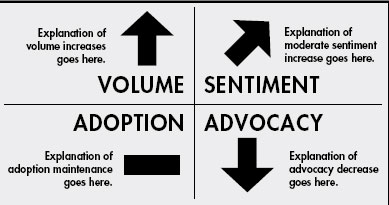By Curtis Hougland
We are witnessing the arrival of data-driven PR. Finally, PR is measurable.
The lack of effective measurement throughout PR's history stems in part from its principal benefit--awareness. If you want to foster brand awareness this side of $100 million,
PR is a great solution. However, measuring awareness through impressions and circulation has always been inadequate, if not altogether misleading, and the measurement has been as
time-consuming as the work itself.
Word of mouth, not editorial, is now the single most influential factor in purchasing decisions and brand advocacy. Unlike awareness, WOM requires an action and, as result, is
measured by participation or adoption. This starts to sound a lot like interactive marketing, but it's PR--really.
What's different today is consumer adoption. 69% of all Internet users participate in social media, with 45% publishing content (Deloitte & Touche, 2007). Not only is more
a media (both traditional and social) consumed online, but this communication is far more transparent due to technology. This transparency results in the publishing of scads of
data; data, of course, is the backbone of measurement.
What also makes measurement more possible today is that the very structure of the Internet is dedicated to sparking and spreading word of mouth (customers) and its corollary
buzz (prospects) through inbound blog links, applications, relational databases, instant messenger and RSS--just to name a few.
As it turns out, social media translates far more into participation, especially through natural search performance, and traditional media translates far more into awareness.
So, this virtuous circle between top-down and bottom-up media bridges objectives, awareness and adoption with more data available across all media.
So, how do you do it?
1. Identify a data partner, or tap into public tools such as Compete, Hitwise Quantcast, Google, Alexa, Technorati or SEOMOZ to extract data.
2. Organize measurement into four buckets (see chart):
-
Volume (volume of conversation, reach of conversation, inbound blog links)
-
Sentiment (tonal sentiment, theme coherence)
-
Engagement (views, friends, fans, downloads)
-
Advocacy (virality, authority, unattributed sales)
3. Benchmark performance metrics based on a company's objectives against its competitors. Each industry is different.
4. Commit to real-time monitoring across all media, especially to identify changes in volume that presage large opportunities and impending crises, and create a
customized Report Card with this info.
5. Update the Report Card monthly to provide ongoing measurement.
6. Plan based on what the data is telling you.
By tracking these performance metrics under a greater charter for PR, we paint a picture of a brand's performance across all media. Since we commit to a benchmark at the onset,
we are able to truly measure the performance of our work in PR. This basic approach to measurement has broad implications for the PR industry in terms of our need for technology
and ability to interpret visualize data.
It also begins to alter the fundamental planning process, because we are basing decisions on data. The entire PR planning process then looks something like this:
-
Figure out who is saying what about you and where your competitors are in the media through a variety of performance metrics.
-
Interpret what the data means in the context of what you know about the industry.
-
Prescribe a solution based on the data.
-
Optimize and measure.
This is PR for the CMO--that is, PR that commands access to greater budgets and respect, because it correlates work to tangible success. PRN
CONTACT:
Curtis Hougland is the founder of Attention PR. He can be reached at [email protected].

